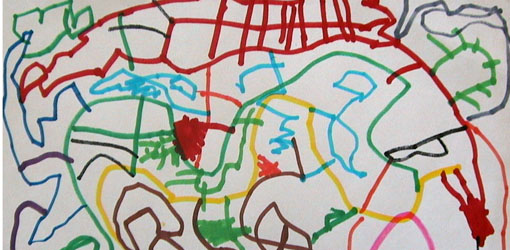Mapping Mapping
Posted on December 10, 2009 | posted by:
It’s remarkable to me how much the idea of “mapping” comes up in the discussions I’m part of and the courses that I teach or visit. Without much commotion, the process has lodged itself at the heart of various disciplinary practices (architecture, graphic design, urban design…). Emerging out of the practices of diagramming, data visualization and information architecture, it seems to have broadened in scope to comprise a way of seeing and organizing the world. Why now? It’s not surprising to see it on the rise. As we encounter vast and complex arrays of data and information—combined with the rise of network culture—mapping offers a way to foreground particular types of relationships (of proximity, of kind, across time, of connection) in a format that lends itself to quick, visual comprehension. It is, quite simply, faster to consume these connections when they’re presented visually. Or so the hypothesis goes.
What I’m mostly struck by, however, is the tendency to generate woefully ineffectual maps and to present them in highly decontextualized ways. I cannot tell you how many times I’ve seen these maps that aspire to convey complex relationships very clearly, but actually completely obfuscate things. They are often visually distinctive, so we’re happy to stare at them, but I always ask myself, “What have we learned through this mapping that we couldn’t have learned otherwise?” While it is possible to chalk this up to a nascent field and the lack of practitioners trained in it, I also think we need to start to develop more critical tools, faculties, and vocabulary when it comes to the practice of mapping. Without question mapping is a powerful lens through which to organize information, but what distinguishes penetrating from inadequate maps? Are there certain contexts that lend themselves to mapping? Who is teaching it? Who should be teaching it? And based on what methods?
Discussions around mapping often arise at the intersection of design and ethnography as a way to present ethnographic insight in ways that fit with a design sensibility. One quality of mapping is that it seems to lend itself to group, or collaborative, work. Large teams can collectively map a space or setting more effectively than an individual, often, and the discussions that making a map elicit can be remarkably insightful. Mapping will be part of the curriculum of the Transdisciplinary Design program, but we need to directly confront the practice and the teaching of it. Does mapping have an ontology? What can it do and what are its limits? How and when should mapping fit into the design process? Is it research, method, or artifact? As we begin to reflect on mapping—to map mapping—we’ll be in a better position to determine its real impact.